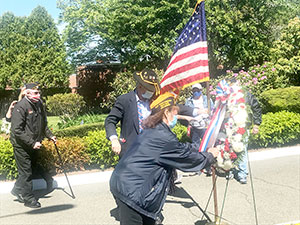(The opinions and views expressed in the commentaries and letters to the Editor of The Somerville Times belong solely to the authors and do not reflect the views or opinions of The Somerville Times, its staff or publishers.)

— Photo by Matt McLaughlin
By Matthew McLaughlin
Somerville City Council President
Every Memorial Day television networks show war movies filled with heroic acts and graphic violence. Prior to World War II, however, military personnel were more likely to die from disease than bullets, bombs or bayonets. No camera could ever capture their struggle against an invisible enemy, one that does not recognize borders or sides.
The last time Americans dealt with anything close to our current situation was the Influenza pandemic of 1918. Known as the Spanish Flu because Spain was the only country willing to acknowledge the disease, the first recorded American cases were in Fort Riley, Kansas. Soldiers carried this disease to the European theater where it spread across the battlefield. Neither side wanted to acknowledge the silent suffering of their troops lest they appear weak to the enemy. These veterans didn’t have the luxury to shelter in place. They didn’t even have the luxury of penicillin. Their shelter was a trench and their hospitals were more dangerous statistically than crossing No Man’s Land.
Death by disease was a fact of life throughout history, and the military always suffered the most due to the extreme conditions they are exposed to. For every three soldiers killed in action during the Civil War, five more died from disease. Valley Forge is a symbol of American resilience during the Revolutionary War, not for an epic battle, but just for surviving. Of the 2,000 patriots who died at that encampment, two thirds died from disease like dysentery, typhoid and typhus.
Even today American troops deal with a dual front of the battlefield and Covid-19. As of May 22, 5,959 troops were diagnosed with Covid-19, 161 were hospitalized and two died. Troop withdrawal in Afghanistan is currently hindered due to quarantine. For those veterans lucky enough to survive war, many are dying from disease due to poor health and living conditions, such as the more than 50 veterans who died at the Soldier’s Home in Holyoke.
The sacrifices of these brave men and women put into perspective the sacrifice of wearing a mask outside and staying home whenever possible. While some bemoan basic precautions as a violation of their civil liberties, the veterans who succumbed to disease throughout history would gladly trade their trench for a couch and their gas mask for a piece of cloth.
Sacrifice comes in many forms. Those who made the ultimate sacrifice should be honored, whether they died by machine gun or malaria. Those of us who benefit from their sacrifice have a responsibility to remember them and must strive to create a world where war and disease are prevented at all cost.












Reader Comments